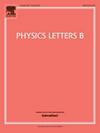Probing the weak gravity conjecture: Novel Aschenbach signatures in superextremal non-linear charged AdS black holes
IF 4.5
2区 物理与天体物理
Q1 ASTRONOMY & ASTROPHYSICS
引用次数: 0
Abstract
This study investigates the nonlinear charged Anti-de Sitter (AdS) black hole solution within the framework of massive gravity, motivated by recent advancements linking the Weak Gravity Conjecture (WGC) to phenomena such as Weak Cosmic Censorship Conjecture (WCCC) and photon sphere dynamics. Building on these foundations, we focus on the Aschenbach effect–a relativistic phenomenon intricately tied to the geometry of photon spheres and known to occur in some special sub-extremal non rotating black holes. Our primary objective is to determine whether this effect persists not only up to the extremal limit but also beyond, into the superextremal regime, thus probing the stability and validity of black hole characteristics in these extreme conditions. By analyzing the nonlinear charged AdS black hole solutions in massive gravity, we demonstrate that the Aschenbach effect remains a robust feature across both extremal and superextremal configurations. This extension suggests that key relativistic signatures and the underlying spacetime structures associated with high-spin black holes continue to hold beyond classical boundaries. Our results provide new insights into the behavior of ultra-compact objects and highlight promising directions for exploring the limits of general relativity, as well as potential generalizations of the WGC and WCC in strong gravitational fields.
探索弱引力猜想:超极端非线性带电AdS黑洞中的新奥森巴哈特征
由于弱引力猜想(WGC)与弱宇宙审查猜想(WCCC)和光子球动力学等现象的最新进展,本研究在大质量引力框架下研究了非线性带电反德西特(AdS)黑洞解。在此基础上,我们聚焦于奥森巴哈效应,这是一种与光子球体几何结构紧密相关的相对论现象,已知会发生在某些特殊的亚极值非旋转黑洞中。我们的主要目标是确定这种效应是否不仅持续到极端极限,而且还持续到超极端状态,从而探索黑洞特征在这些极端条件下的稳定性和有效性。通过分析大质量引力下非线性带电AdS黑洞解,我们证明了奥森巴哈效应在极端和超极端构型中仍然具有鲁棒性。这一扩展表明,关键的相对论特征和与高自旋黑洞相关的潜在时空结构继续超越经典边界。我们的研究结果为超致密天体的行为提供了新的见解,并为探索广义相对论的极限以及WGC和WCC在强引力场中的潜在推广指明了有希望的方向。
本文章由计算机程序翻译,如有差异,请以英文原文为准。
求助全文
约1分钟内获得全文
求助全文
来源期刊

Physics Letters B
物理-物理:综合
CiteScore
9.10
自引率
6.80%
发文量
647
审稿时长
3 months
期刊介绍:
Physics Letters B ensures the rapid publication of important new results in particle physics, nuclear physics and cosmology. Specialized editors are responsible for contributions in experimental nuclear physics, theoretical nuclear physics, experimental high-energy physics, theoretical high-energy physics, and astrophysics.
 求助内容:
求助内容: 应助结果提醒方式:
应助结果提醒方式:


